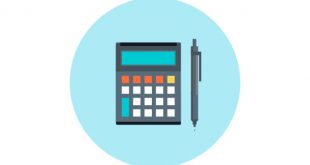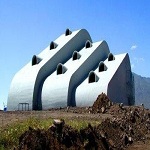 An ultra modern building that could have belonged to another galaxy stands in the arid plains of northeastern Anatolia near Bayburt, a traditional town in the Black Sea region. The 4 juxtaposed buildings in different length are in the shape of cylinders buried in the ground. For some reason, as I first look at their pictures, they reminded me of submarines! This striking architecture becomes more inspiring once one visits the galleries. Baksı Museum is designed on surprising contrasts: you can walk through a rich collection of contemporary art pieces side by side traditional handicrafts.
An ultra modern building that could have belonged to another galaxy stands in the arid plains of northeastern Anatolia near Bayburt, a traditional town in the Black Sea region. The 4 juxtaposed buildings in different length are in the shape of cylinders buried in the ground. For some reason, as I first look at their pictures, they reminded me of submarines! This striking architecture becomes more inspiring once one visits the galleries. Baksı Museum is designed on surprising contrasts: you can walk through a rich collection of contemporary art pieces side by side traditional handicrafts.
The opening exhibition of the museum in 2010 displayed Turkish contemporary art of various artists: Ali Kazma, Alp Sime, Aslımay Altay, Ayşen Urfalıoğlu, Aziz Sarıyer, Beril Anılanmert, Burak Bedenlier, Esma Paçal Turam, Gülay Semercioğlu, Güler Güngör, Hüsamettin Koçan, Kurucu Koçanoğlu, Murat Morova, Mürteza Fidan, Nermin Er, Ramazan Bayrakoğlu, Suzi Hug Levi, Şakir Gökçebağ, Tuğrul Selçuk and Zafer Mintaş. They represented tradition and art in sculpture, painting, video and installations. The fashion designer Özlem Süer featured modern clothing using traditional ehrams as fabric.
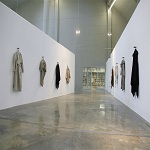 Ethnographic pieces in the gallery have been collected over the years by Hüsamettin Koçan, the founder of the museum. Local artifacts mainly consist of ehram and pottery. Pottery is the symbol of the earth and ehram the nomadic way of life. Pieces take us to a voyage in time and place by giving us hints about tools Anatolian people had used everyday, different beliefs they had practiced and rituals they had lived by.
Ethnographic pieces in the gallery have been collected over the years by Hüsamettin Koçan, the founder of the museum. Local artifacts mainly consist of ehram and pottery. Pottery is the symbol of the earth and ehram the nomadic way of life. Pieces take us to a voyage in time and place by giving us hints about tools Anatolian people had used everyday, different beliefs they had practiced and rituals they had lived by.
The name of the museum Baksı is the former name of the Bayraktar village where the museum is located. Baksı means in Kirgiz Turkish, Shaman, which can be interpreted as healer, helper and protector. These auspicious meanings also match well with the museum’s mission.
Hüsamettin Koçan, a Bayburt native artist and art professor, founded the museum with a vision. He wanted to create an art community with visiting artists who would contribute to the artistic trends and exhibit their work in the museum. He also wanted to revive folkloric art by educating the locals in weaving traditional kilims and ehrams unique to the region. He wanted the museum to impact not only the local art but also the economy by creating new jobs for local women.
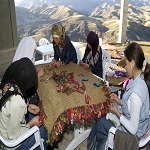 For this reason, Baksı Culture and Art Foundation has partnered with DPT’s Social Support Programme in order to give weaving courses to young women in Bayburt. Besides weaving techniques, the courses will include entrepreneurship lessons for those who would like to sell their handicrafts. Baksı Museum also seeks contacts in international markets for exporting opportunities. In this end, Baksı Museum recently attended Importshop Berlin Fair with a display of handwoven ehrams and kilims and made a successful first attempt to meet potential international buyers.
For this reason, Baksı Culture and Art Foundation has partnered with DPT’s Social Support Programme in order to give weaving courses to young women in Bayburt. Besides weaving techniques, the courses will include entrepreneurship lessons for those who would like to sell their handicrafts. Baksı Museum also seeks contacts in international markets for exporting opportunities. In this end, Baksı Museum recently attended Importshop Berlin Fair with a display of handwoven ehrams and kilims and made a successful first attempt to meet potential international buyers.
Currently, the museum management is working on an exhibition themed ‘Distance and Contact.’ There are a few different categories in design, which already enticed my curiosity and appetite. While Arzu Kaprol is working with three young designers on a new fashion collection, Engin Akın is running a project on reviving the forgotten tastes of the region. Akın’s goal is to gather old regional recipes of jams and pastes, and produce them for the local and national market. There is also work in progress on the industrial design with Faruk Malhan, who made up a small team of successful industrial design and architecture students. The teamwork sponsored by Koleksiyon is in the process of designing and manufacturing original products.
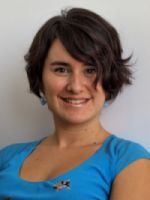 Ela Erozan Gürsel writes a weekly column named “Değişim Yelpazesi ” on global business trends for Dünya Gazetesi on behalf of Datassist for almost two years. Her feature topics include: green energy; climate change; impacts of financial crisis on companies, sectors and regions; innovative technologies in sciences, human resources and management; social networks transforming business and politics; changing dynamics of marketing and branding.
Ela Erozan Gürsel writes a weekly column named “Değişim Yelpazesi ” on global business trends for Dünya Gazetesi on behalf of Datassist for almost two years. Her feature topics include: green energy; climate change; impacts of financial crisis on companies, sectors and regions; innovative technologies in sciences, human resources and management; social networks transforming business and politics; changing dynamics of marketing and branding.
She also writes articles for international magazines published in Singapore.
Prior to her writing career, she worked at Datassist as a Project Manager in a project that combines human resources and mobile communications with the aim to connect blue-collar workers and employers through mobile phones. Before engaging in this exciting project, she was in pharmaceutical sales working for a multinational company. She graduated from American University, Washington, DC, majoring in International Studies with a concentration on International Business and Europe. She worked in Washington D.C. as an Account Manager at a boutique telemarketing firm that specializes in fund raising and publication renewals. She speaks Turkish, English, French, and Spanish. She currently resides in Singapore with her husband.
All these projects are inspiring for artists, students and general public, who would like to be proud of the richness of the Turkish culture. For these cultural projects to last and prosper, museums need to be financially supported by the government agencies, private sector and international foundations. I hope Baksı Museum will keep up its creative projects with the help of professionals’ efforts and get the attention of potential sponsors in order to further contribute to the local economy and art.
 Turkish Labor Law
Turkish Labor Law
